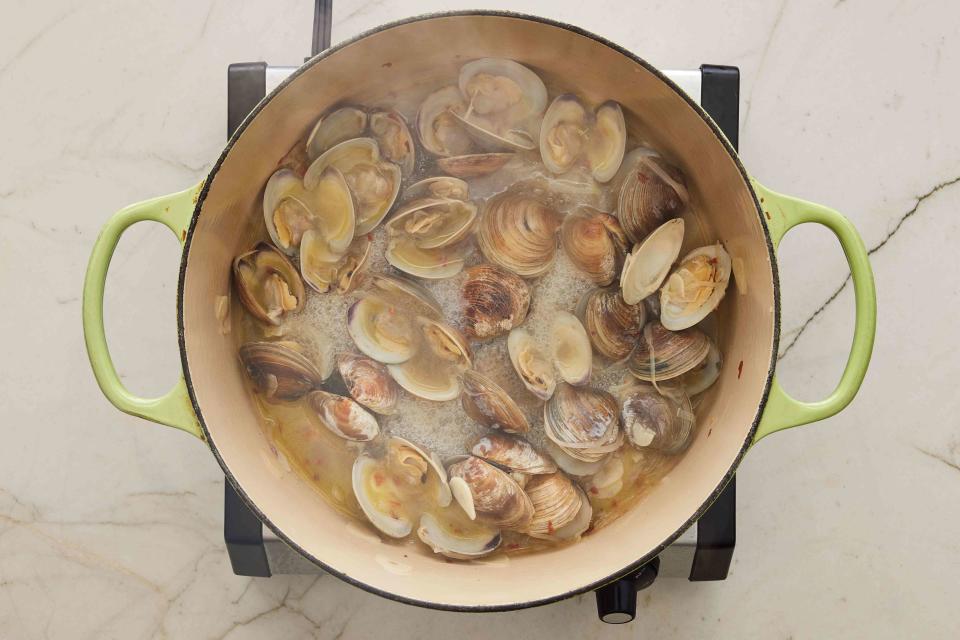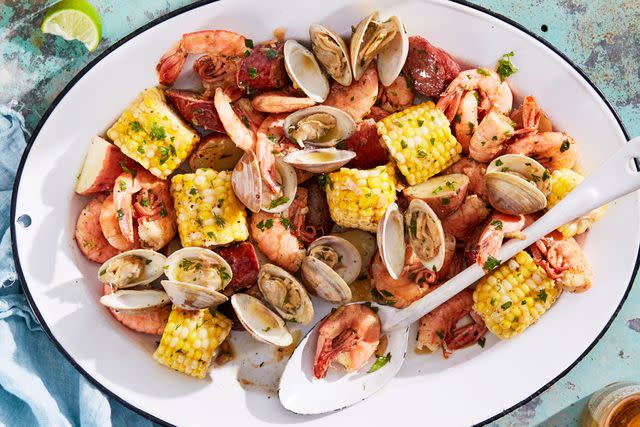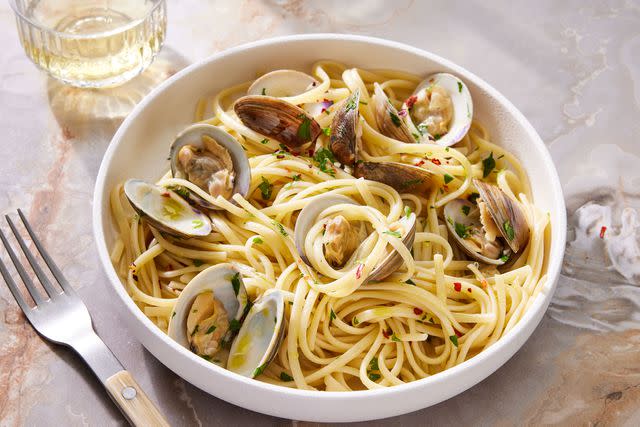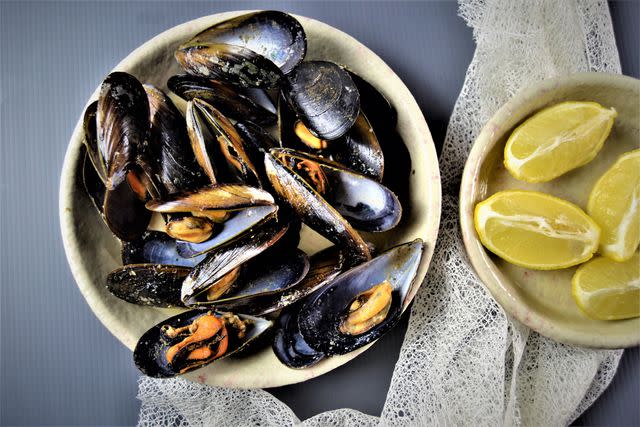What's The Difference Between Clams And Mussels?
They're both similar and very different.

Robby Lozano, Food Stylist: Chelsea Zimmer
It's not everyday that most of us are shopping for or cooking up clams and mussels. Perhaps you're planning on doing a Feast of the Seven Fishes or want to prepare a classic cioppino.
No matter the dish, it can be intimidating to cook clams and mussels, especially the first time around. From the different types of clams and mussels you might encounter at the store, to how to cook with each, we'll break down how these mollusks are both similar and different, and what to know about them before you get cooking.
Meet The Expert
Erin T. Spencer is a marine ecologist and science writer who is passionate about sharing inspiring stories of marine conservation. As a National Geographic Explorer, she's traveled from Florida to Fiji to learn how communities can work together to protect our oceans' fisheries. Learn more about her work at erintspencer.com.
How Clams And Mussels Are Similar
Both clams and mussels are bivalve mollusks (along with oysters and scallops) that have two-part hinged shells and a soft body. They are both filter feeders, meaning they subsist on nutrients they glean from the moving water they filter through their gills. (Yes, they have gills just like fish!) They feed on plankton and other microscopic organisms.
They're both sustainable food choices (more on that below) and can both grow in fresh or saltwater, with the specific habitat they're raised in contributing to their flavor. Both cook quite quickly and will pop open when fully cooked and ready to eat. (Any clams or mussels that don't open up should be discarded. Same with any that are already open before cooking.)
How Clams And Mussels Are Different
The biggest differences between the two comes down to flavor and texture: Mussels have a creamier, tender texture in comparison to clams that have a little more chew to them. That said, if mussels, or clams for that matter, are overcooked they'll both be extremely chewy and rubbery.
As for flavor, generally mussels are milder and less briny than clams, which have a stronger seafood flavor. They also look very different visually, which we'll get into below.
How To Tell Them Apart
Don't feel bad if you struggle to decipher between clams and mussels. Once you know what to look for, it's easy to tell them apart (although you can always ask the fishmonger, if ever in doubt).
"Most clams have oval-shaped shells (the razor clams have longer, more rectangular shells) that can be tan, brown, or white in color. Mussels have much darker shells, more like a brown or black, and can have a blue-purple sheen to their shells. Also their shells are more teardrop-shaped when compared to clams," says Erin T. Spencer, marine ecologist and science writer.
Another visual difference is that mussels have a bundle of thin fibers that protrude from their shell that they use to stick to rocks or other mussels. These fibers are referred to as beards. Many farmed mussels come with them already removed, but if you purchase mussels with the beards still attached, it's easy to pull them off and discard.

Linda Pugliese; Prop Stylist: Kay Clarke; Food Stylist: Anna Hampton
Types of Clams
These are some of the common kinds of clams you're likely to encounter at your local fish market.
Steamers
You'll often see these sweet, tender clams on restaurant menus labeled "steamers," but they can also be called soft shell clams. As the name implies, they're delicious steamed and served with butter (although truthfully, most clams are), and they have a more brittle shell compared to other varieties, hence the soft shell moniker, so they should be handled with care.
Manila
These clams are small, soft, sweet, and have a light briny flavor. You might also find them labeled asari, which is the Japanese name for this variety. Know that when looking for them in store, Manila clam shells range in color from white to yellow, brown, or gray, with concentric rings and lines running across them. They're classically used in pastas, soups, and simply steamed. They are found in the Philippines, South and East China Seas, the Yellow Sea, the Sea of Japan, among other places, including along the West Coast.
Quahogs
Also called hard clams or hard-shell clams, quahog is the umbrella term that encompasses a large size range of clams found from Florida to Canada that can grow up to about 6 inches. A few common varieties are countneck, littleneck, topneck, cherrystone, and chowder, and they are named according to size. They're versatile in terms of cooking, and have a mild, sweet flavor with a pleasantly briny taste.
Razors
Razor clams are long, narrow, saltwater clams that are shaped like a closed straight razor, hence the name. There are many types of razor clams, but Pacific razors are one popular variety. In terms of preparation, you'll often see them fried or used in chowders.
"The most commonly-known species, razor clams are native to estuaries of China and Japan and, according to Monterey Bay Seafood Watch, are one of the top five most important bivalve aquaculture species," says Spencer.

Robby Lozano, Food Stylist: Chelsea Zimmer
Types of Mussels
When shopping for mussels, use this guide to help you understand the varieties often found in the seafood case.
Blue
Tender and sweet, these mussels come from tidal areas or offshore, mostly from New England, Washington, and California, and are the most widely consumed mussels in North America. They can be enjoyed a variety of ways, from steamed to baked.
"Found on the East and West Coasts, these little guys can grow up to eight inches. They can also be called PEI mussels if harvested from Prince Edward Island. They'll have black or brown shells with blue-purple hues," says Spencer.

Getty Images
Mediterranean
These mussels, as the name alludes, are from the Mediterranean and Atlantic coast of Europe. Mild with a firm texture, you'll see them smoked, broiled, and steamed, but it's worth noting that the variety has been introduced in other parts of the world and is considered invasive in many of those locations. They're even listed as one of the top 100 worst invasive species by the International Union for Conservation of Nature. These mussels look very similar to blue mussels, but are typically larger. Their shells can be a deep blue color, brown, or almost black.
New Zealand Green-Lipped
Larger than blue mussels, these get their name from the green "lips" around the edges of their shells. They're also simply known as New Zealand mussels. Plump, juicy, and sweet, serve them steamed, in pasta, or stuffed and baked.
Seafood Watch
Spencer recommends visiting the sustainable seafood guide from Monterey Bay Aquarium called Seafood Watch. The resource has a color-coded scale to sustainable seafood options, from salmon to mollusks. Any seafood labeled green means it's a great sustainable choice, with yellow indicating a good alternative, and red labels denoting that seafood that's should be avoided.
The good news is that "bivalves like clams and mussels are considered some of the most sustainable seafood options you can buy," says Spencer.
Wild vs. Farmed
"Wild caught bivalves can be dug by hand or dredged, while farmed ones can be grown on the sea floor or suspended in the water column in protective bags or on longlines," says Spencer.
The majority of clams and mussels you'll find in stores are farmed. As Spencer notes, about 90 percent of the global bivalve production is farmed, according to Monterey Bay Seafood Watch.
While a valid concern with farmed seafood is what is used as feed, bivalves, which are filter feeders that extract nutrients out of moving water, don't require an additional food supply that could contain less than ideal ingredients. Plus, "as they filter their food, they're making the water cleaner!" she says.
Can You Substitute Clams for Mussels in Cooking, and Vice Versa?
The answer to this question is highly recipe specific. Clams and mussels are often used in conjunction in dishes, and can be similarly steamed in rich bathes of white wine and fresh herbs, but they do cook at different rates, especially depending on size, and might not be a suitable one-for-one swap depending on the recipe.
In a fish stew, for example, if clams aren't available, mussels would be a fine substitute (although they will impart a different flavor). While the mussels might cook at a different rate than the clams, luckily it's easy to tell when they're done: they'll pop right open.
Related: 63 Delicious Reasons to Eat More Seafood
For more Southern Living news, make sure to sign up for our newsletter!
Read the original article on Southern Living.

